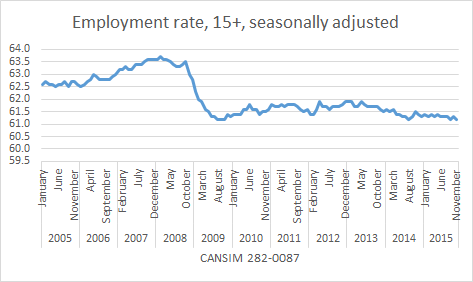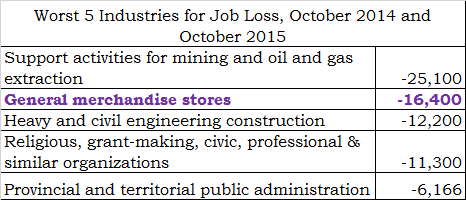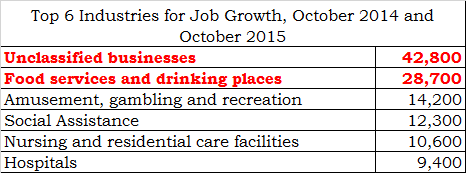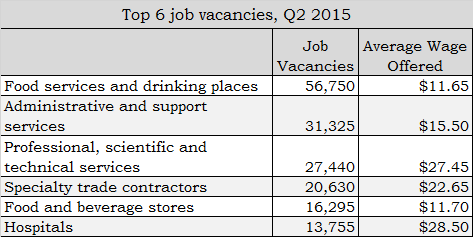Jobs and Growth after the Great Recession
This is the time of year when articles list their favourite things about last year, and their “things to watch” for the next year.
Naturally, my “things to watch” list will always include the labour market. Where have we seen the strongest job growth or worst job losses, and what are the trends that might affect this in the coming year.
We know that the employment rate (the proportion of Canadians over 15 who have a job) has never really recovered from the 2008 / 2009 recession. While this is partly because of demographic trends, I still think that this is an important indicator to watch, as it reflects the proportion of the adult population in paid employment. Full employment is a worthwhile goal, as jobs are still the main way that we create wealth / distribute income.
So where are the jobs going to be in 2016?
Well, we know where they weren’t in 2015. Looking at the most recent SEPH data by industry, the impact of lower oil prices are clear. The table below compares the employment levels in industries at the three digit NAICS level. Support activities for resource extraction tops the list of job losses over the past year, by a wide margin. General merchandise stores comes in second, and I’ve bolded it because it is the only industry that makes the worst 5 list both in the past year, and since October 2008. Perhaps surprisingly, provincial and territorial public admin makes the top 5 list for job losses.
On a more positive note, let’s see where the growth is happening. SEPH data in recent years has had a disproportionate number of unclassified businesses, so it is no surprise that this is the *industry* with the most employment growth over the past year. More meaningful is the employment growth in food services, social assistance, and hospitals. Again, food services is bolded because it made it into the top 5 list for the past year, and since October 2008. (I’ve included 6 industries here because of a connection with the job vacancy data).
So how does this job growth compare to reported vacancies, perhaps a better indicator of where short term job growth will be coming from? Food services and drinking places tops the job vacancies list too. Unfortunately for workers, the average wage offered in this industry is the lowest of all reported in the Job Vacancy and Wage Survey.
A better indicator for workers might be where are wages rising, and where are they falling. Over time the new Job Vacancy and Wage Survey should be able to give us a decent understanding of this. Right now we only have two data points, Q1 and Q2 of 2015, when we were smack dab in the middle of an oil shock induced recession. For what it’s worth, so far the fastest growing wages on offer are in data processing, financial investments, and high tech manufacturing. The biggest wage offer declines were seen in natural resource sectors.
Where are the jobs with decent wages going to be in 2016? Demand in health care and social services will continue, but nearly all provincial governments are coming up against self-inflicted revenue constraints which will affect both hiring and wages in this sector. Low wage jobs abound, so movements like #Fightfor15 become even more important. Unions and other civil society groups that are pushing for better employment standards for precarious workers, and for universal benefits will become even more necessary in the next few years.





Thank you for this insightful overview of the labour situation across Canada. An initiative which would ensure both full employment and better employment standards for precarious workers is the Job Guarantee which offers minimum livable wage plus benefits plus training and sets the bar for the private sector. See letter below published in Hill Times with footnotes also sent to editor.
http://www.hilltimes.com/letters-to-the-editor/2015/11/16/trudeau-should-revive-expand-local-initiatives-program-says-kazdan/44199
Re: Canada’s labour force enjoys temporary spike in jobs, likely election work: Statcan, Andy Blatchford, 11.05.2015
http://www.montrealgazette.com/business/newsalert+economy+added+44400+jobs+unemployment+rate+drops+cent/11497904/story.html
Canada’s labour force ballooned last month thanks to a surge in temporary public-administration work likely generated by the federal election. Economists have have also recorded increases in employment after natural disasters or during wars when massive government outlays pour into the economy. But governments don’t have to to wait for catastrophes to spend. During the Great Depression when private business activity was subdued, governments successfully put people to work through New Deal programs. In the 1970s the Liberal government also experimented with direct job creation delivered through local organizations and citizen groups. The Local Initiatives Program successfully hired in areas such as arts and culture, recreation, tourism, research and protecting the environment.
Conservative ideologues would have us worry about government waste but they overlook the high social cost of keeping people unemployed – increased rates of family breakdown, increased crime rates, increased alcohol and substance abuse, increased suicide rates, and lost opportunities for skill development and work experience among the young. As the British economist John Maynard Keynes recognized years ago, “The Conservative belief that there is some law of nature which prevents men from being employed, that it is “rash†to employ men, and that it is financially ‘sound’ to maintain a tenth of the population in idleness for an indefinite period, is crazily improbable – the sort of thing which no man could believe who had not had his head fuddled with nonsense for years and years…”.
If Justin Trudeau were serious about creating jobs for Canadians, he would revive and expand the Local Initiatives Program begun under his father’s administration.
Footnotes:
1. The Job Guarantee: A Government Plan for Full Employment
http://www.thenation.com/article/161249/job-guarantee-government-plan-full-employment
“The benefits of full employment include production of goods, services and income; on-the-job training and skill development; poverty alleviation; community building and social networking; social, political and economic stability; and social multipliers (positive feedbacks and reinforcing dynamics that create a virtuous cycle of socioeconomic benefits). An “employer of last resort†program would restore the government’s lost commitment to full employment in recognition of the fact that the total impact would exceed the sum of the benefits.”
2. Public service employment programs – what really have we got to fear?
http://bilbo.economicoutlook.net/blog/?p=20679
> Boondoggling and leaf-raking – it is the term that invokes the ultimate put down by the conservatives who laud the virtues of the private sector as they create hundreds of thousands of low-skill, low-paid, precarious and mind-numbing jobs but hate, with an irrational passion, the idea that the public sector could employ workers that the private sector doesn’t want and get them to work on community development projects at a minimum wage. And to put a finer point on it … on projects that can leave massive positive legacies to all that follow.
3. Keynes quote:
http://www.nakedcapitalism.com/2011/12/wray-on-krugman-and-currency-sovereignty.html